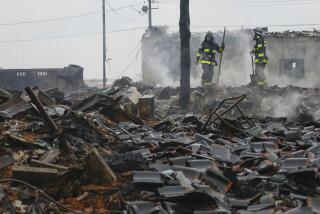Japan fears a nuclear disaster after reactor breach
Reporting from Tokyo and Los Angeles â â Dangerous levels of radiation escaped a quake-stricken nuclear power plant after one reactorâs steel containment structure was apparently breached by an explosion, and a different reactor building in the same complex caught fire after another explosion, Japanâs leaders told a frightened population. Authorities warned that people within 20 miles of the crippled reactors should stay indoors to avoid being sickened by radiation.
FOR THE RECORD: An earlier version of this story incorrectly spelled the first name of Japanese Prime Minister Naoto Kan as Naoko.
The fast-moving developments at the Fukushima No. 1 (Daiichi) plant, 150 miles north of Tokyo, catapulted the 4-day-old nuclear crisis to an entirely new level, threatening to overshadow even the massive damage and loss of life spawned by a devastating earthquake and tsunami.
Prime Minister Naoto Kan, in a nationwide address to the Japanese people, called for calm even as he acknowledged the radiation peril. Dressed in industrial-style blue coveralls, he offered solemn assurances that authorities were doing âeverything we canâ to contain the leakage.
Photos: Scenes of earthquake destruction
âThere is a danger of even higher radiation levels,â he said â chilling words to a nation where the atomic bombings of Hiroshima and Nagasaki in the waning days of World War II are known to every schoolchild. Slightly elevated radiation was detected in Tokyo, but not at health-affecting levels, officials said.
Cabinet Secretary Yukio Edano, speaking shortly afterward, said radiation levels around the plantâs six reactors had climbed to the extent that âwithout a doubt would affect a personâs health.â But he insisted that outside the existing 12-mile evacuation zone, there was little or no health danger.
But people anywhere close to the plant were told to turn off ventilators drawing air from outdoors and not to hang laundry in the open air in order to avoid contamination.
The announcements, more than 12 hours after the situation at the Unit 2 reactor at the Fukushima plant began to deteriorate with the exposure of its fuel rods to air, heightening the threat of meltdown, generated anger and fear in the earthquake-affected area and beyond. Many Japanese do not believe that either the government or the plantâs operator, Tokyo Electric Power Co., have been forthcoming about the extent of the danger amid a series of malfunctions at Fukushima.
The mayor of a small city that falls partly within the evacuation zone offered an unusually harsh public critique of the utility and Kanâs administration.
âThe government and Tokyo Electric Power have neglected to update residents with accurate information,â Kazunobu Sakurai, the mayor of Minamisoma, told the public broadcaster NHK. âWe need the government to keep us informed, to send emergency supplies and to help move residents who are inside the evacuation zone.â
Survivors of the U.S. atomic bombings in World War II have been criticizing the nuclear power companyâs handling of the crisis.
âNuclear power generation has been said to be safe but it was proved that itâs very fragile,â Hirotami Yamada, 79, bureau chief of the Nagasaki Atomic Bomb Survivors Council, told Kyodo.
The explosion followed an early morning acknowledgment from Tokyo Electric Power that, because of human error, the fuel rods inside the Unit 2 reactor had been at least partly exposed to air for more than two hours during two separate incidents the previous evening, allowing them to heat up and causing a buildup of explosive hydrogen gas. Independent experts said it was a grave development that heightened the risk of an uncontrolled release of radiation into the environment.
Authorities also disclosed that a fire broke out at the complexâs Unit 4 after a blast left two gaping holes in an outer wall. The fire was later reported to have been extinguished, though it was unclear what caused it.
The International Atomic Energy Agency said Japanese officials told them that the explosion and subsequent fire were located at the unitâs spent-fuel storage pond and that radioactivity was being released directly into the atmosphere.
By Tuesday afternoon, Kyodo was reporting that the pond was boiling because the water level was too low. Workers were struggling into the evening to pump more water into the pond.
Authorities also reported that the only two reactors where explosions have not occurred â Units 5 and 6 â were registering rising temperatures.
The U.S. government mobilized emergency resources to help Japan grapple with the developing nuclear crisis, dispatching a team of Nuclear Regulatory Commission experts late Monday, activating an atmospheric radioactivity monitoring center at Lawrence Livermore National Laboratory in the Bay Area and rushing additional Navy ships to the region.
In the best-case scenario, the situation at the damaged reactors will take weeks, if not months, to stabilize, U.S. nuclear experts said.
âThey do not have the situation under control,â said Robert Alvarez, a nuclear expert at the Institute for Policy Studies and a former Energy Department official.
The companyâs acknowledgement that a âsuppression poolâ at the bottom of Unit 2, designed to serve as a last line of defense against a meltdown, was believed to have been breached could represent a major escalation of the crisis, said Victor Gilinsky, a former member of the Nuclear Regulatory Commission.
âIf that is true, then there is a path to the control room, the workers and the outside environment,â he said.
The cooling problems at Unit 2 represent the most serious development yet in the crisis at the plant, said nuclear specialist Edwin Lyman of the Union of Concerned Scientists.
When the fuel rods get too hot and react with water, they produce hydrogen gas that vents from the reactor into the containment building. When enough hydrogen accumulates, it becomes explosive. Containment buildings around two other reactors at the Fukushima complex already suffered explosions, on Saturday and Monday.
Engineers had begun using fire hoses to pump seawater into the Unit 2 reactor â the third at the plant to receive the last-ditch treatment â after the emergency cooling system failed. Company officials said workers were not paying sufficient attention to the process, however, and let the pump stall, allowing the fuel rods to become partially exposed to the air.
Once the pump was restarted and water flow was restored, another worker inadvertently closed a valve that was designed to vent steam from the containment vessel. As pressure built up inside the vessel, the pumps could no longer force water into it and the fuel rods were once again exposed.
Four officials from Tokyo Electric Power in dark suits and looking somber began their nationally televised news conference hours after the onset of the problems at the Unit 2 reactor by bowing and apologizing for the worry caused.
In something of a contradiction, officials at Japanâs Nuclear and Industrial Safety Agency said that, even in a worst-case scenario, the three troubled reactors at Fukushima had been depressurized by the release of radioactive steam, which would decrease the destructiveness of any breach, according to Kyodo News.
But other nuclear experts said it remained possible that an overheated uranium core in any of these reactors could melt down and breach its containment vessel, exposing the environment to a radioactive plume.
The seriousness of the situation was further underscored Monday when the French Embassy in Tokyo advised its citizens to move away from Japanâs capital to protect themselves against possible radiation exposure.
A flight ban was imposed within 20 miles of the Fukushima plant because of the radiation danger. Air China and two Taiwanese carriers, Eva Airlines and China Airlines, canceled flights to Japan over radiation fears.
The U.S. Navyâs 7th Fleet also said Monday that it had ordered the aircraft carrier Ronald Reagan away from Fukushima after detecting low-level contamination when it was about 100 miles northeast.
Nearly 200,000 Japanese had already been evacuated from a 12-mile zone surrounding the plant, and the company said it had moved 750 workers away from the plant, leaving 50 to deal with the crisis.
In the U.S., the Nuclear Regulatory Commission said Monday that it had received a formal request from Japan for assistance and was sending 10 people with expertise in boiling-water reactors. Agency spokesman Scott Burnell said the experts knew that they might have to âundergo radiation doses larger than normal.â
Another serious risk involves the more than 200 tons of spent nuclear fuel that is stored in pools adjacent to the reactors, Alvarez said. Those cooling pools depend on continually circulating water to keep the fuel rods from catching fire. Without power to circulate the water, it heats up and potentially boils away, leaving the fuel rods exposed to air.
An aerial image of the Fukushima plant shows the loss of high-capacity cranes needed to move equipment to service the reactor. The photo also appears to show that the spent fuel pool is steaming hot, which may indicate the water is boiling off, Alvarez said.
U.S. nuclear experts said they were particularly concerned about the Unit 3 reactor because it is fueled in part with plutonium, an element used in hydrogen bombs that can be more difficult to control than the enriched uranium normally used to fuel nuclear power plants.
The U.S. Department of Energy activated the National Atmospheric Release Advisory Center at Livermore to create sophisticated computer models of how the radioactive releases from Fukushima No. 1 would disburse into the atmosphere. The center, which was created to deal with contamination in the event of a nuclear war, played a key role in predicting contamination patterns during the 1986 Chernobyl nuclear crisis.
Even before the admission of how serious the problems at the Fukushima complex had become, there were signs that the legendary patience and politeness of Japanese in the face of such adversity was wearing thin. In Natori, north of Tokyo, the top floor of the City Hall was repurposed into a disaster-relief center. There, in an oft-repeated scene, a woman in red pants and a brown coat berated government workers for sitting comfortably in their offices with heat, 24-hour power and water while the rest of the prefecture lacked basic services.
Voice cracking, she said the government had been far too slow in restoring the electricity and repairing roads and basic infrastructure.
âSheâs complaining that our operation doesnât work so well,â said Chizuko Nakajima, a government worker in the senior citizen department, who was helping distribute food as an emergency volunteer. âActually, itâs true. Weâre so overwhelmed.â
Adding to the sense of anxiety, strong aftershocks have rippled across a wide area since Fridayâs quake, with fresh jolts shaking Tokyo on Tuesday. Japanâs Meteorological Agency said Saturday there was a 70% probability of another powerful temblor in the coming three days.
Photos: Scenes of earthquake destruction
King reported from Tokyo and Vartabedian and Maugh from Los Angeles. Times staff writers Barbara Demick in Sendai, Mark Magnier in Natori and David Pierson in Beijing contributed to this report. Special correspondents Kenji Hall and Yuriko Nagano contributed from Tokyo.
More to Read
Sign up for Essential California
The most important California stories and recommendations in your inbox every morning.
You may occasionally receive promotional content from the Los Angeles Times.











